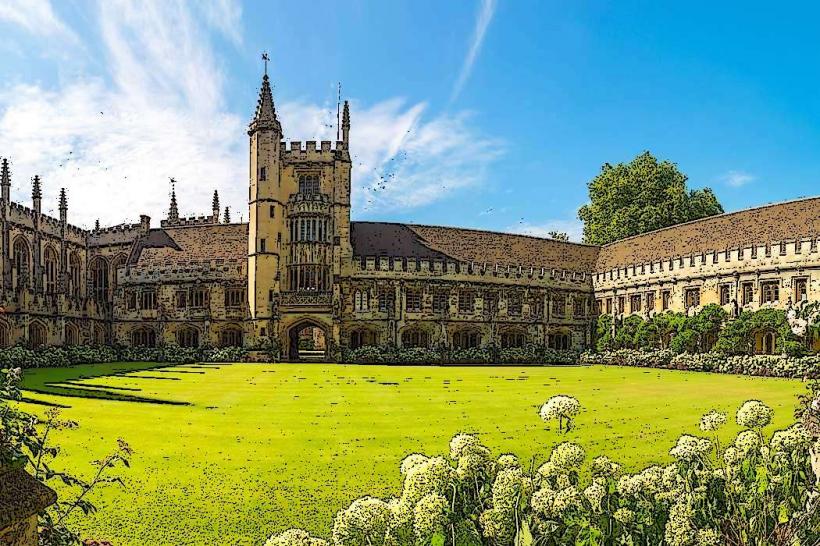Information
Landmark: Oxford Botanic GardenCity: Oxford
Country: United Kingdom
Continent: Europe
The Oxford Botanic Garden is one of the oldest botanic gardens in the United Kingdom and serves as both a place of beauty and scientific importance. Established in 1621, it is located on the banks of the River Cherwell in the heart of Oxford, near Magdalen Bridge, and is part of the University of Oxford. The garden is dedicated to the study and conservation of plant species, as well as providing an accessible and peaceful green space for visitors.
History and Origins
The Oxford Botanic Garden was founded by Henry Danvers, the Earl of Danby, in 1621 as a physic garden for the study of medicinal plants. Its original purpose was to provide a place for the teaching and research of botany, particularly focusing on the cultivation of plants with medical properties. The garden’s first curator, John Tradescant, was a renowned horticulturist and explorer who helped collect plants from around the world.
Over the centuries, the garden has expanded its scope and evolved to include a wide variety of plant species for both educational and ornamental purposes. It has remained an important resource for botany students at the University of Oxford and has developed into a public attraction, drawing visitors from around the world.
Key Features and Collections
The Oxford Botanic Garden spans about 4 hectares (10 acres) and is divided into several distinct areas, each showcasing different types of plant life and garden styles. Some of its key features and collections include:
1. The Walled Garden
- The heart of the botanic garden is the walled garden, which contains a variety of plants, including medicinal herbs, aromatic plants, and species used in scientific research.
- It is home to herbaceous borders, climbers, and many traditional English garden plants. The garden’s structure also creates a microclimate that helps grow species that require a more sheltered environment.
2. The Tropical Glasshouse
- The Tropical Glasshouse is one of the most striking features of the garden. It houses a diverse collection of tropical plants, including orchids, ferns, and exotic trees from rainforests around the world.
- This glasshouse simulates the humid, warm conditions of tropical environments, offering visitors a chance to see plant species that would not typically thrive in the UK climate.
3. The Alpine and Rock Garden
- The Alpine Garden showcases plants that grow in high-altitude environments, including alpine meadows and rocky outcrops. It is arranged to replicate the conditions of mountainous areas, with specially designed rocks and slopes to mimic the natural habitat of these plants.
- This section features species from a variety of locations, including the Alps, Himalayas, and the Andes.
4. The Herb Garden
- The Herb Garden focuses on plants that have been used historically for medicinal, culinary, and aromatic purposes. It contains a wide variety of herbs, ranging from common garden herbs like rosemary and thyme to more unusual species.
- The garden also highlights the historical importance of plants in medicine and human culture.
5. The Riverbank Garden
- The Riverbank Garden borders the Cherwell River and showcases plants that thrive in wetland environments. This area highlights species that are adapted to damp conditions, including water-loving plants like marsh marigolds, irises, and water lilies.
6. The Wildlife Garden
- The garden also features a wildlife garden, designed to attract birds, insects, and small mammals. It uses native plants and habitats to create a haven for local wildlife, helping to preserve biodiversity in the city.
7. The Modern Glasshouses
- In addition to the Tropical Glasshouse, the Oxford Botanic Garden has modern glasshouses that house plants from Mediterranean and temperate climates, further enhancing the diversity of its collections.
Educational and Research Role
As part of the University of Oxford, the Botanic Garden plays a significant role in the education and research of plant sciences. It is used by university students, researchers, and faculty for studies related to botany, ecology, conservation, and plant biology. The garden offers students hands-on experience with live specimens and provides resources for their academic work.
The garden is also actively involved in conservation efforts, both in terms of maintaining rare and endangered species and promoting environmental sustainability. Through its research and educational initiatives, the garden helps to raise awareness of issues like climate change, habitat loss, and plant conservation.
Visitor Experience
The Oxford Botanic Garden is open to the public and offers visitors a chance to explore its collections, learn about plant science, and enjoy a peaceful retreat from the bustle of the city. Some features that enhance the visitor experience include:
- Guided Tours and Talks: The garden offers regular guided tours and educational talks, allowing visitors to learn more about the history of the garden, the plants it contains, and the science behind its collections.
- Workshops and Events: Throughout the year, the garden hosts a variety of workshops and special events, including plant sales, gardening advice sessions, and seasonal celebrations.
- Café and Gift Shop: The garden features a café, where visitors can relax and enjoy refreshments while taking in the beautiful surroundings. The gift shop offers a variety of gardening-related books, tools, and souvenirs.
- Seasonal Changes: The garden is known for its seasonal beauty, with different plants blooming throughout the year. In spring and summer, visitors can enjoy vibrant flowers, while autumn brings colorful foliage, and winter offers a more tranquil, quieter atmosphere.
Conclusion
The Oxford Botanic Garden is a place of both historical and scientific significance. It has played an important role in botany and plant science for centuries and continues to be a living resource for education, research, and conservation. With its diverse collections, beautiful landscapes, and commitment to sustainability, it remains one of Oxford's most treasured and tranquil spaces, offering both scholars and visitors alike a chance to connect with nature.









